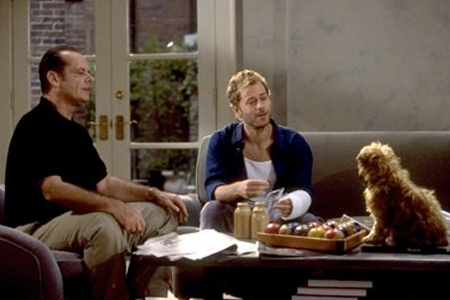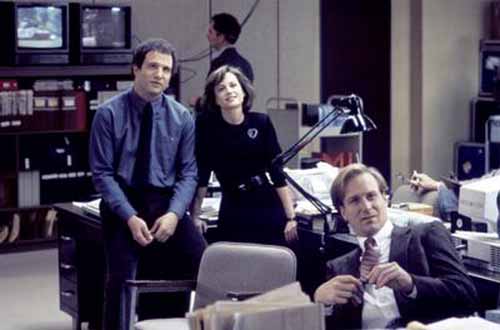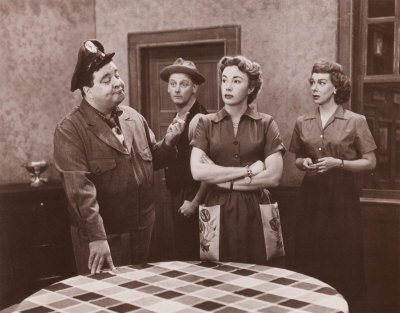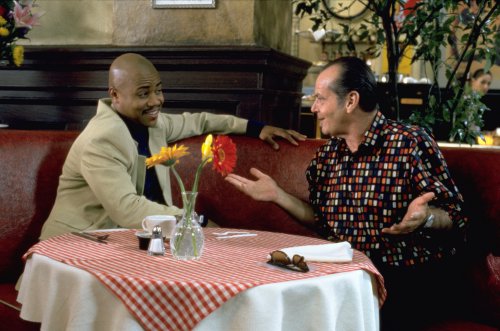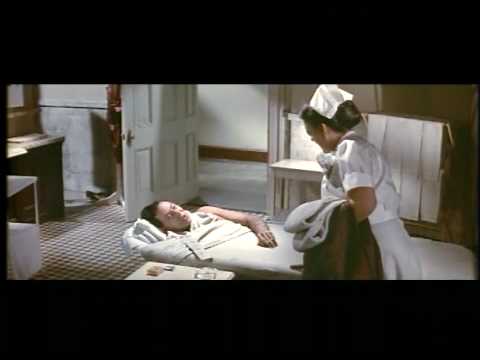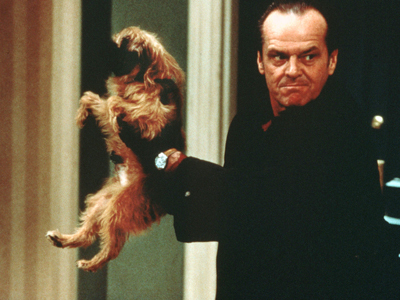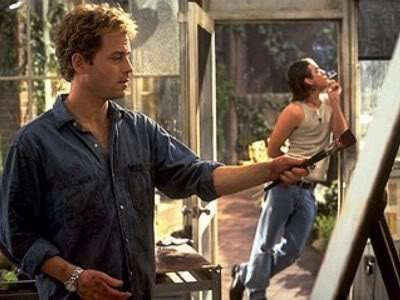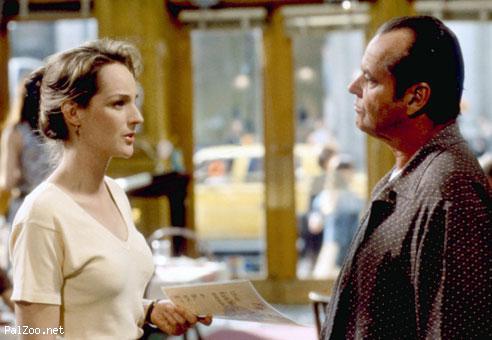From the Chicago Reader (December 29, 1997). To tell the the truth, over 17 years later, I’m a little embarrassed about having given this movie four stars. For all my affection for James L. Brooks, in spite of everything (and including his most recent picture, the much-reviled How Do You Know), this is far from being his best work. — J.R.
As Good as It Gets **** Masterpiece
Directed by James L. Brooks
Written by Mark Andrus and Brooks
With Jack Nicholson, Helen Hunt, Greg Kinnear, Cuba Gooding Jr., Skeet Ulrich, Shirley Knight, Yeardley Smith, Lupe Ontiveros, Jesse James, and Jill.
As a TV illiterate who probably hasn’t watched a sitcom regularly since The Honeymooners, who’s never seen Taxi, Rhoda, Lou Grant, Room 222, or The Tracey Ullman Show, and caught only the final episode of The Mary Tyler Moore Show, I don’t know much about the world James L. Brooks sprang from as an artist. In fact, apart from several episodes of his two cartoon series, The Simpsons and The Critic, I don’t know his TV work at all. And as someone who regards movie test-marketing as one of the sleaziest, most destructive practices in Hollywood, I’m more than a little skeptical about a writer-director-producer who believes in it so religiously that after the previews of his previous feature, the musical I’ll Do Anything, he recut it so extensively he made it a nonmusical.
Given my biases, I’m hard put to explain what I find so remarkable about As Good as It Gets, though Brooks’s movies, starting with his second feature, Broadcast News, have long been guilty pleasures of mine. He’s made quantum leaps since his first feature, Terms of Endearment — not because he abandoned his sitcom reflexes but because he adapted them to the requirements of Hollywood features, test-marketing included. How he emerged an abler artist is worth puzzling over; I suspect it has something to do with sheer instinct triumphing over industry machinery. I’ve read that As Good as It Gets has been tested with five separate endings — so there’s a distinct possibility that one or more of the rejected four was superior to what Brooks wound up with, because immediate responses to previews aren’t always sound. I’ve also read that uncertainty dogged Brooks all the way through the film’s production; not knowing precisely what tone he wanted to achieve until he arrived at it, he shot take after take after take. Some of this uncertainty is apparent in the film, especially in the raw and spontaneous feel of the performances. Any synopsis of As Good as It Gets is likely to make the movie seem like a shameless soap opera combined with an abrasive comedy, and any proper account of its style and metaphysics has to include the fantasy world we associate with musicals. But it’s the danger as well as the promise of all these emotional registers that are finally communicated; I often felt like I was walking on a tightrope with Brooks and his actors.
One of the reasons Brooks’s fourth feature excites me so much is that it clarifies what I find so special about Broadcast News (which opened here ten Christmases ago) and I’ll Do Anything. This generally involves the pathos and comedy of superneurotics struggling to cope with other people in the everyday world, which includes on occasion the bonds between them and other superneurotics. I’m thinking in particular of Holly Hunter and Albert Brooks in Broadcast News and of Nick Nolte and Albert Brooks in I’ll Do Anything, but also of the less neurotic types they often struggle to relate to: William Hurt in Broadcast News and Joely Richardson and Julie Kavner in I’ll Do Anything. It hasn’t always been easy to separate Brooks’s talent in this department from the specific energies of his actors. One moment I’ve always treasured from Broadcast News relates to the siblinglike complicity and intimacy between the characters played by Brooks and Hunter, when he says to her on the phone, “OK — I’ll meet you at the place of the thing where they met that time,” a line that for all I know was contributed by Albert.
By contrast, As Good as It Gets has only one superneurotic — an obsessive-compulsive novelist named Melvin Udall (Jack Nicholson) — though he’s such an advanced case he makes the four in Broadcast News and I’ll Do Anything seem relatively normal. The two other central characters in As Good as It Gets — a gay Greenwich Village painter named Simon (Greg Kinnear) who’s Melvin’s next-door neighbor and a single mother and waitress named Carol (Helen Hunt) who works in the Village but lives in Brooklyn — are relatively sane individuals with one pronounced neurotic trait each: Simon’s compulsive concern for his dog Verdell (in effect a fourth major character, played mainly by a dog named Jill) and Carol’s compulsive concern for her chronically asthmatic son, Spence (Jesse James). (Brooks originally wanted Holly Hunter to play Carol, and it’s easy to imagine him considering Albert Brooks to play Melvin, though it’s hard to believe the film could have worked as well with either actor, despite their obvious skills.)
It would appear that Brooks has refined his comic examination of neurosis by reducing the number of his characters and improving what might be regarded as his laboratory conditions. But the problem with this sort of analysis is that it assumes that “characters” means the same thing in TV sitcoms and Hollywood features; I don’t believe it does, in spite of Brooks’s struggles to reconcile irreconcilable forms. What he winds up with, in fact, is a frank contradiction: characters and situations that seem artificial when viewed in toto but that are painfully truthful as they’re unfolding. The short-term narrative units of sitcoms require characters to exhibit all of their most important traits in self-contained, hyperbolic bursts between commercial breaks rather than allow them to gradually unfold. The fact that these characters can assume mythic weight over weeks or years has more to do with the familiarity and persistence of those traits than with their expansion. This doesn’t mean that surprising revelations or developments are impossible in sitcoms, only that they’re seriously limited because they must conform to the characters’ mythic familiarity before they can perform any other function. (Comic strip characters are sometimes freer because they can persist longer: over decades Li’l Abner can eventually marry Daisy Mae and have a son while still remaining Li’l Abner, but Ralph Kramden having a child — or getting a job other than bus driving — seems inimical to The Honeymooners.) Consequently, there’s a profound conservatism inherent in the world sitcom characters inhabit, where character flaws can never be overcome because this would upset the market for these characters as they already exist.
This same conservatism is what I continue to find so problematic about the films and persona of Woody Allen and certain other pop culture standbys I value more. If neurosis (Allen), corpulence (Oliver Hardy), racism (Archie Bunker), and stupidity (Krazy Kat) continue to attract paying customers, who wants to see an Allen with his problems licked, a Hardy signed up with Weight Watchers, a Bunker who’s discovered tolerance, or a Krazy Kat enrolled in college? So we become complicit in the perpetuation of their problems, indulging them as we would spoiled pets, chuckling at their permanence.
What makes Brooks a rather quixotic figure, at least when he’s making movies, is that he passionately wants his characters to change; in spite of everything — including his bread and butter — he’s rooting for them to improve. That’s why in I’ll Do Anything he becomes devoted to the notion of a temperamental and self-centered actor (Nolte) becoming a better father to his little girl, even after she seems more likely to succeed in his profession than he does, and to the even less plausible notion of Melvin Udall overcoming his antisocial behavior to become a plausible partner for a waitress some 30 years younger than he is. Thanks to Brooks’s sitcom reflexes, we may decide that these developments are undesirable and perhaps even impossible, but he won’t give up wishing them to happen. Each time Brooks confronts this sort of problem in a feature he seems to raise the stakes. It’s been over a decade since I saw Terms of Endearment, perhaps the most doggedly sitcommy of all his features, so I won’t attempt to deal with it here. But in Broadcast News — where he’s trying to simultaneously unpack the profession of TV news reporting, study the behavior of gifted but dysfunctional individuals within this world, and raise ethical questions regarding both — he manages to succeed only in the second endeavor; everywhere else he’s sending up smoke screens. In I’ll Do Anything, a near remake, he shifts the base of operations from Washington, D.C., to Hollywood (another company town) and from TV news to feature filmmaking; here he’s juggling even more characters and taking on additional challenges — including attempting to address all these issues in terms of a musical — with comparably mixed results. (The prerelease musical version of I’ll Do Anything was a good deal better than the nonmusical release version — in spite of an uneven score — if only because it’s so much more emotionally coherent. But it’s still a movie that has much more to say about the nature and ethics of neurotic behavior than it does about moviemaking or professional ethics.)
Having jettisoned the ambition to say something about either a media profession or its ethics, As Good as It Gets may seem to be aiming at something more modest. But because its moment-to-moment focus is the emotional interplay between three disparate (and desperate) individuals, all of whom live with genuine catastrophe in their lives, it becomes clear that Brooks has changed his overall game plan — including his definition of what constitutes a character. (I’m deliberately avoiding what “catastrophe” means in all three cases so as not to give away too much of the plot.)
Taken as complex individuals unfolding and developing over 138 minutes, Melvin, Carol, and Simon are freakish, hyperbolic collections of traits that arguably never quite add up to coherent or believable individuals. But they’re never quite satisfying as sitcom perennials either, if only because they all show marked capacities for change. Yet moment to moment their interactions are terrifyingly, beautifully, and comically real — even if they’re often “real” as distinct from “realistic” in the way that some of the best musical comedies are. Intimately concerned with the embarrassment and difficulty of constant repositioning and mutual readjustments and with all the ethical issues that arise from this activity — the same sort of issues that abound in the films of Leo McCarey (such as My Son John and An Affair to Remember) and Vincente Minnelli (such as The Cobweb and The Band Wagon) — these interactions are the mother lode that all of Brooks’s features have been searching for. Starting and ending with dubious premises, Brooks and his collaborators apparently kept working with the materials at hand until they finally arrived at some sort of bedrock truth.
The only one of these characters who has a meaningful “back story” is Simon — an account of his break from his parents that’s recounted roughly halfway through the film — and because of this he’s the least defined, the least volatile, and the most conventional member of the trio. Having a back story implies that achieving peace of mind entails coming to terms with one’s past, as Simon eventually does — the therapeutic model for dealing with neurosis in most conventional Freudian or post-Freudian Hollywood movies, from Alfred Hitchcock’s Spellbound to Albert Brooks’s Mother. But this isn’t an option for either Carol or Melvin, who succeed or fail only in terms of how they cope with the immediate past and the present. Consequently, we never hear a word about the father of Carol’s son — and we aren’t in the least concerned about this absence. Similarly, the only time Melvin has anything to say about his apparently traumatic childhood — during a car trip to Baltimore, when he rudely interrupts Simon’s telling of his back story — Carol promptly tells him to shut up, and we don’t feel deprived that we don’t hear any more.
No less than three “psychiatric consultants” are credited at the end of As Good as It Gets, but whether Melvin represents a plausible example of a person with a clinical obsessive-compulsive disorder or a sitcom version of one is ultimately a moot point. “There’s something wrong with Melvin,” Brooks is quoted as saying in the press book, “but the nature of what is wrong with him is that he spends his life disguising what’s wrong with him.” If this is true, Brooks seems to have little compunction about not dealing with what’s wrong with him. (Brooks inherited the script from someone named Mark Andrus, so perhaps he doesn’t know.) As cowriter and director, he ticks off Melvin’s obsessive-compulsive traits — a set of daily rituals involving cleanliness, locks, light switches, cracks in the sidewalk, where he eats out, and who serves him at the restaurant; a habit of elaborately insulting whomever he happens to be talking to; obnoxious solipsism — but he never gets around to explaining their source.
If Carol and Melvin appear to exist for us only in the present, this is at least partly a result of their sitcom heritage. Within the first few minutes of the movie it’s quickly established that Melvin is both homophobic and racist, but these facts are offered less as character traits — though they eventually function as such — than as curveballs to be caught or fumbled by the audience. (Apart from his dislike of the dog Verdell, these are virtually the first facts established about him, which immediately establishes our uncertainty about him.) We also learn that Melvin’s a romantic novelist who’s on the verge of completing his 62nd book and who recites his prose while punching it out on a word processor — none of which I find especially easy to swallow. It’s typical of Brooks’s method that his characters tend to become detached from their professions; one might even have problems accepting that Nolte is an actor in I’ll Do Anything. Simon, who’s supposed to be a painter in a garret, might as well be Gene Kelly in An American in Paris — a notion that’s planted when Simon plays some of the Gershwin suite on his stereo — while Melvin noodling on his piano next door becomes a clear stand-in for Oscar Levant.
Yet because Melvin is being played by Jack Nicholson, a host of other associations come into play. For example, the cartoonlike, devilish leer that increasingly informs his performances — from Carnal Knowledge to The Shining to The Witches of Eastwick to Batman — is given a new spin by Melvin’s clearly troubled nature, so that Nicholson’s performance encompasses an implied retroactive autocritique (much as Marlon Brando’s performance in The Freshman offered a revision of his performance in the title role of The Godfather or as Clint Eastwood obliged us to reconsider John Huston’s actorly persona in White Hunter, Black Heart). As someone who’s grown weary of Nicholson’s exercises in ingratiation even though his talent is obvious, I’m grateful that he’s taken this opportunity to stretch his range and put everything he’s done before in a more critical light, exposing the insecurity that always lurked behind the glibness. Carol, by contrast, is a heady mixture of impulsive cheerfulness, commonsensical comebacks, precipitous mood swings, and cascading rage. Thanks to the fleetness of Hunt’s expressions, she’s every bit as unpredictable as Melvin, and we’re as likely to follow her down just as many treacherous paths. And though she’s more believable as a “real” person than either Melvin or Simon, she’s as much a musical-comedy waitress as Melvin is a musical-comedy intellectual and Simon a musical-comedy painter. (The Village restaurant where she works and where Melvin eats every day could have come out of Funny Face — an ambience that’s most apparent when Melvin gets ejected in her absence for his boorish behavior and the other customers applaud.) Her efforts to write Melvin a grateful letter in Brooklyn using a dictionary — topped by her reading portions of it aloud to him in the restaurant after he refuses to read it himself — are quintessential MGM backlot tropes illuminated by wonderful, nuanced acting. And when, much later, she actually dances a few steps across a crowded dance floor toward Melvin in a Maryland seafood restaurant, Hunt’s apotheosis is complete.
It’s fair to say that however deeply Brooks’s procedures are grounded in sitcoms, embellished by the world of musicals, and curtailed by test-marketing, his focus remains on the possibility of strangers finding some emotional footing together and changing as a result of their efforts — something we all have to cope with every day without the simplifications of sitcoms, musicals, or audience surveys. Considering how much of the real world and its perils leaks into this movie, one wonders how much Brooks’s taste and background facilitates his quest and how much they get in the way. Now if he can only be allowed — or can allow himself — to make a proper musical, without sitcom styling or test-marketing, with a decent score and real characters, he may even be able to surpass this movie.

